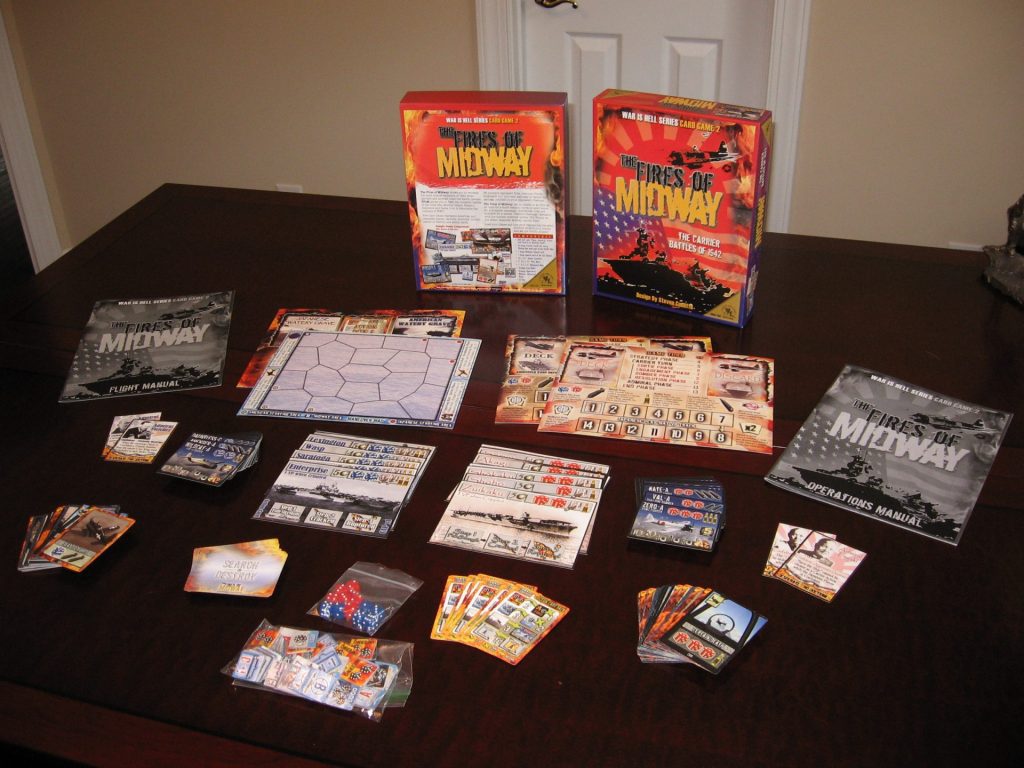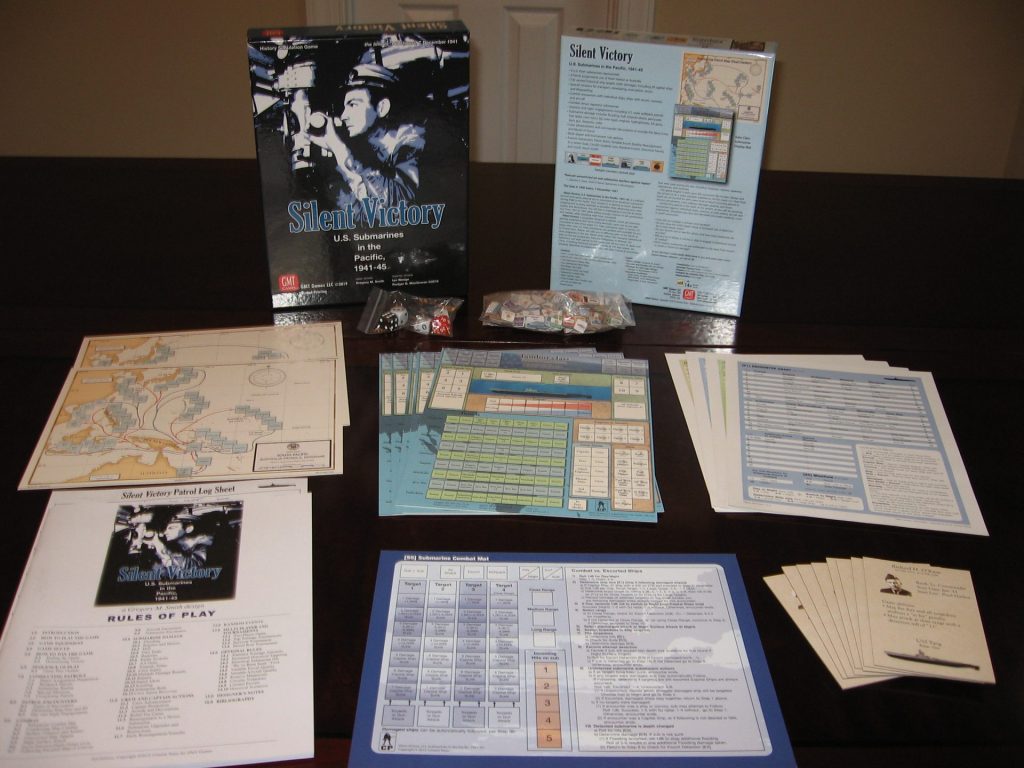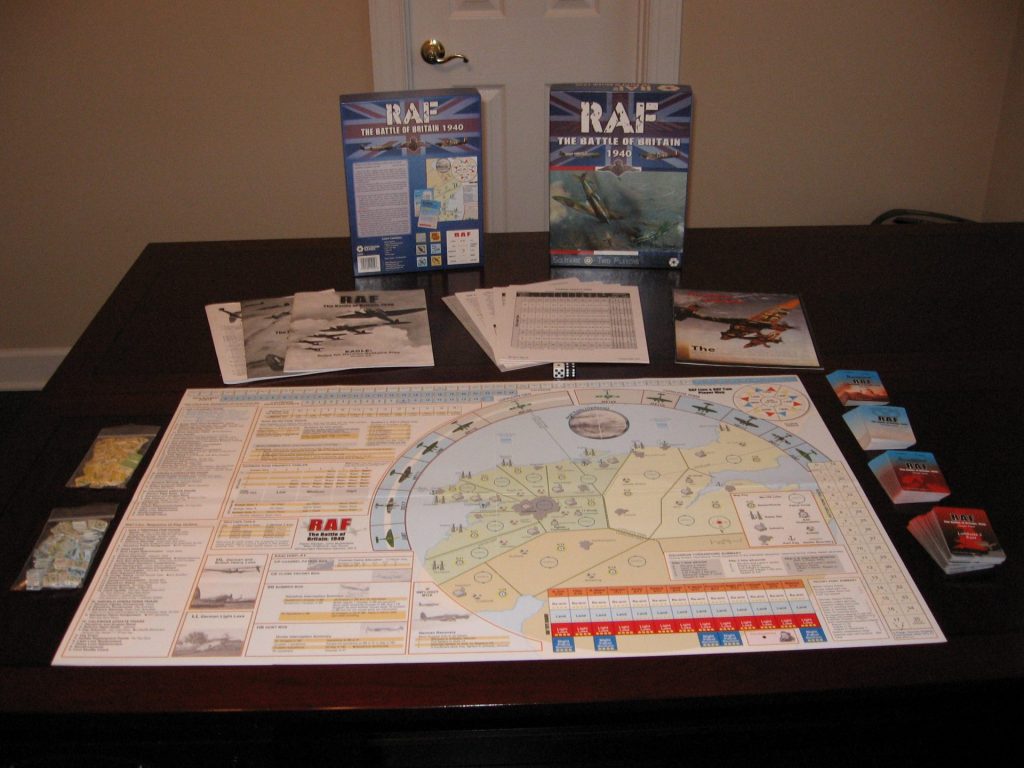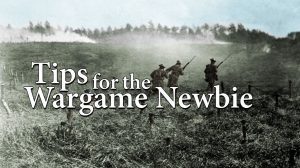Whether you’re relatively new to wargaming or an old grizzled Grognard, you will likely play a game solitaire at some time. Perhaps more than other types of boardgames, wargames are often played solitaire. There are lots of reasons why. For many, it’s difficult finding others interested in the hobby. There’s also the time commitment required to play and finish some wargames because they can’t be played in a single evening. And sometimes you just want to play alone, just like you’d want to play solitaire card games or do a jigsaw puzzle. But whatever the reason, most wargames can be played solo, especially if there is no hidden information. The player just plays both sides – most wargames are designed for two players – to the best of their ability.
Solitaire Friendly vs. Designed for Solitaire Play
While it is true many wargames are solitaire friendly, more and more wargames are being published today that are designed to be played solitaire, either exclusively or both solitaire and against an opponent. In a designed-for-solitaire game, the designer has created an artificial intelligence (AI) engine that regulates the actions of your opponent. How the AI works varies from game-to-game. Regardless of the mechanics, this is good news for the novice wargamer who may be learning to play wargames for the first time. Why? Well, it’s not very fun getting whooped by an experienced wargamer. You may never want to play that game again. It also makes it possible to play at your leisure when time permits.
Purposely designed solitaire wargames also tend to be very thematic. They are designed to put you into the action in a way that is different from traditional multi-player wargames. A good example is B-17, Queen of the Skies. Published in 1981 by Avalon Hill, it was one of the very first games designed to be played solitaire. In addition to placing the player into the role of the commander, these games tend to be more intimate and personal. You’re not just the general in the rear area giving orders, you’re the commander of an aircraft or ship making life and death decisions for you and your crew. This storytelling is one of their chief appeals.
I have not played every solitaire wargame out there. That said, here are my picks for the top six wargames designed to be played solitaire. All of these games are fairly new and can still be purchased from the publisher or on the secondary market. They are also lower in complexity than some other solitaire wargame titles on the market, making them easy to master for a new wargamer. I’ve listed them in increasing levels of complexity as rated on the BoardGameGeek 5-point scale.
A Wing and a Prayer: Bombing the Reich (Complexity Rating 2.14)
This game draws on some of the same concepts first seen in B-17, Queen of the Skies. But rather than simulating an individual B-17, in A Wing and A Prayer (from Lock ‘n Load Publishing) you command an entire formation of bombers. Designed by Erik von Rossing and published in 2016, the object of the game is to gain victory points by successfully bombing your assigned targets while minimizing bomber losses.
The game is played on a map sheet of northwest Europe and a flight formation card sheet. You begin by determining your mission by a random card draw. The card specifies the target, how many bombers you can assign to the mission, and the number of escort fighters. You then assign individual bombers and crews from your available pool, which are then laid out on the formation card. A counter representing your entire bomber formation starts in England and flies from space to space on the map sheet to your target.

Certain spaces are marked with anti-aircraft guns, which may cause some bombers to be damaged or destroyed before your target is reached. Once over the target, you will face more anti-aircraft guns and enemy fighters. Those bombers that survive aerial combat and don’t drop out of the formation due to damage can then bomb the target. The formation then must retrace their way back to England and land. All the action is regulated using die rolls on charts and tables.
The artwork in this game is just magnificent. It uses vintage photographs from the war, and the counters are large and thick. The 44-page rulebook is written in large font and extensively illustrated. You can play campaigns from 5 up to 25 missions in length, with each mission typically taking no more than 20 minutes to play. Your crews can go from green, to veteran, to crack, thus enhancing their abilities…that is until they are shot down and lost. That’s what makes this game so engaging. You really get attached to your bomber crews. Optional rules allow you to play this with two players, one American fighter and one German.
The Fires of Midway (Complexity Rating 2.56)
Released by Clash of Arms Games in 2010 and designed by Steven Cunliffe, this game can be played against an opponent or solitaire. In solitaire mode, you can play either the American or Japanese side and fight one of four carrier battles: the Battle of Coral Sea, the Battle of Midway, the Battle of the Eastern Solomons, and the Battle of Santa Cruz. Each side commands one or more aircraft carriers and tries to locate and sink the other side’s aircraft carriers. This game works primarily because it focuses on 1942 when both sides had roughly the same number of aircraft carriers in the Pacific. As the war progressed, the Japanese were hard pressed to replace their carrier and aircrew losses, while America pumped out both carriers and skilled pilots in prodigious numbers.
The game is card-driven. Each carrier is represented by a large 3×5 card, the front side of which is used until the carrier takes enough damage to become crippled. The reverse side is then used and reduces the carrier’s ability to defend itself. Smaller cards are used to represent different types of squadrons – fighters, dive bombers and torpedo bombers. These too have a full-strength and reduced side. A separate Search and Destroy deck is used to search for the enemy carrier task force(s).

After the search phase ends, these cards are then used to determine the hits scored on enemy carriers. Finally, each player has a deck of Combat Cards that come in three types; Cockpit Combat Cards that are used in aerial combat, Bomber Combat Cards that are used to attack enemy carriers, and Carrier Combat Cards that are used to defend carriers and shoot down enemy aircraft. By comparing the combat cards, each player determines how many dice they get to roll to cause damage to their opponent.
Each scenario takes an hour or less to play. Games are fast and fun, with outcomes that can vary widely. There’s even one scenario that allows the American player to use the USS Nimitz to launch F-14 Tomcats and other jets at the Japanese—a nod to the movie The Final Countdown. The game comes with two rulebooks; a 14-page Flight Manual that has the basic rules, and a 22-page Operations Manual containing the scenarios, advanced rules, multi-player rules, and the solitaire rules. Clash of Arms also makes another game in this series titled The Hell of Stalingrad.
Picket Duty: Kamikaze Attacks against U.S. Destroyers – Okinawa, 1945 (Complexity Rating 2.75)
Staying in the Pacific Theater, Picket Duty by Legion Wargames recreates the Kamikaze attacks against U.S. destroyers screening the invasion of Okinawa in 1945. The game was released in 2013 and was designed by Steve Dixon. It is played on a sheet representing a single destroyer. You play the captain of that ship as you try to fend off wave after wave of Japanese suicide attacks. Each turn the ship is attacked by a random number of aircraft determined by the game’s AI. You must then allocate the ship’s guns – 5-inch, 40-mm, and 20-mm – to fire at each attacking aircraft. Each gun has a specific firing arc so they can’t fire in all directions and, depending on which direction the enemy aircraft are coming from, you may not be able to fire at every plane.

The ship can make evasive maneuvers and call on fire support from other ships and aircraft in the area. Radar, if it’s working, helps reduce the chance of an attack. The ship display on the board allows you to keep track of the amount of damage done to the ship and its effect on maneuvering, hull integrity, list and trim. The display also keeps track of fuel and ammunition spent. You can assign damage control parties to repair damage, allowing you to stay on your assigned picket station longer. But at some point, you may be forced to limp back to port for repair and replenishment. All of the action is controlled by charts and tables that require you to roll dice to determine things like the weather, availability of radar and fire support, if an attack occurs (and if so its size and composition), effectiveness of repairs, and so forth.
This game is tense! Not surprising given it simulates one of the most harrowing forms of naval combat. Besides the rulebook, there is a Charts and Scenarios book that is used to control the game’s AI. The scenarios range from a single attack wave to a campaign representing days or even weeks of combat. Therefore, playing time can vary from less than one hour up to eight hours, but that also means there’s a lot of gaming in the box.
Silent Victory: U.S. Submarines in the Pacific, 1941-45 (Complexity Rating 2.97)
Released in 2016 by GMT Games and designed by Gregory Smith, this game puts you in the role of skipper of an American fleet submarine operating against Japanese merchant shipping and warships. Your objective is to sink as much tonnage as possible without losing your sub and crew in the process. You may also be called upon to perform other special operations, such as intelligence gathering and rescuing downed pilots.
The game is played on a large card representing your submarine, a combat mat, and a patrol map. The AI uses charts and tables to determine things such as your patrol area, whether or not you make contact with enemy shipping, and if so, the number and types of enemy ships. When contact is made, you need to decide whether you’re going to attack on the surface or submerged, at what range to open fire with your deck gun (if surfaced) or your torpedoes, and how many torpedoes to fire at each target. The AI determines whether you have hit the target, whether the torpedo was a dud (the U.S. had lots of problems with defective torpedoes early in the war), and if not a dud, how much damage was caused to the enemy ship. The Japanese ships may also fire back with their guns or attempt to depth charge your submarine.

As the skipper, you’re constantly weighing the risks versus rewards of your attacks. The closer you engage, the more likely you’ll get a hit. But you’re also more likely to be spotted by enemy escort vessels and attacked in turn. You can fire more torpedoes at each ship to increase your chances of a hit and not having a dud, but you only have so many torpedoes onboard your boat. GMT has released several other titles in this series that focus on German U-boat operations in the Atlantic (The Hunters and The Hunted) and Italian submarines operating in the Mediterranean (Beneath the Med).
Enemy Coast Ahead: The Doolittle Raid (Complexity Rating 3.09)
Designed by Jeremy White and released in 2017 by GMT Games, this is one of the most innovative games I’ve ever played and is chock full of agonizing decisions. You play the role of Lieutenant Colonel Doolittle and get the opportunity to play through the entire 1942 raid on Tokyo, from initial planning right through to the climax of the operation, landing (or attempting to land) your B-25s in China. During each phase of the operation, the decisions you make will impact the overall success or failure of the operation.
The game is played on a sheet that is divided into sections that are used for each phase of the operation. During the Planning phase, you must decide who to brief on the planned raid and when. The more people you brief and the earlier you do so, the more likely there will be a leak. But withholding information too long may prevent you from getting the support of Chiang Kai-shek, Josef Stalin and others. You must also decide what modifications to make to your B-25s and how you will handle security while you train your bomber pilots to take-off from an aircraft carrier.

Finally, you must decide where you plan on rendezvousing with the task force that will escort the USS Hornet across the Pacific to your designated launch point. In the Naval phase, you move the USS Hornet and its escorts across the Pacific and hopefully make a successful rendezvous with the USS Enterprise and her task force before proceeding to the launch point. All the while you may be spotted by enemy ships, submarines and aircraft. In the Flight phase, you launch your bombers and fly them to their respective target cities. Your bomber flights are still susceptible to being spotted and attacked by the Japanese, not to mention adverse weather. In the Attack phase each of your bombers make their bomb run, selecting a specific target. Hazards such as anti-aircraft, search lights, barrage balloons, and fighters can be encountered, and even if evaded, you still must bomb accurately. After your bombs are dropped, you continue heading west to landing fields in China and perhaps even the Soviet Union. Some of your bombers may run out of fuel and ditch in the ocean, while others may crash while attempting to land.
This game is intense and provides a lot of different types of activities and decision making. There are so many things that can go wrong and all your decisions will influence succeeding phases. The game comes with a 64-page rulebook, a 40-page scenario book, and a 20-page debriefing manual, plus several player aids. So how can a game with so many rules be accessible to a new wargamer? The answer is that you start by only reading the rules to play the Attack phase. Once mastered, you then begin adding additional phases working from the end of the operation to the beginning. Playing time will vary depending on how many phases you play. As little as 20-minutes for a single attack, up to 6-hours for the entire operation. GMT has another game in this series (Enemy Coast Ahead: The Dambuster Raid).
RAF: The Battle of Britain 1940 (Complexity Rating 3.27)
Designed by one of the most successful solitaire wargame designers, John Butterfield, this game was first published in 2009 by Decision Games. The game can be played two-player or solitaire, and in the latter case you can play as either General Dowding, Commander of RAF Fighter Command, or Field Marshal Goering, Commander of the Luftwaffe. As the RAF player, you attempt to defend targets in southern England from waves of Luftwaffe bombers and their fighter escorts, while trying to preserve your fighters and pilots. As the Luftwaffe, your objective is to destroy British airfields, ports, radar sites, factories and cities, and in the process the RAF itself, so that Hitler can launch Operation Sea Lion – the invasion of Great Britain.
The game is played on one of two map sheets (one when playing as the RAF and one for when playing as the Luftwaffe). Both show the southeast portion of England that was in range of Luftwaffe airfields in France. The sheet also includes various tables, tracks, and other information used to play the game. The aircraft counters represent squadrons of Hurricanes and Spitfire for the RAF, and groups of Stuka, Dornier, Heinkel, and Junker bombers and Messerschmidt fighters for the Luftwaffe. The AI is card-driven and uses four different decks. The front side of Target Cards alert the RAF as to the general area the next raid may be heading toward, but it is only when the back side is revealed that you will know the specific target. Strategy Cards are used to determine the size and composition of the Luftwaffe raid. Event Cards list events that occur while the raid is enroute and over the target, as well as how much time has elapsed that day. Finally, the Day Cards are used once the day is over and determines how many days pass before the next raid and many reinforcements each side receives – not just aircraft, but also key for the British, how many experienced pilots they get to replace losses.

If you are a fan of the movie Battle of Britain, you will love this game. As the RAF player, you can’t just launch all your squadrons at once since it takes time for your aircraft to land, refuel, rearm, and be ready to go back on alert. In the meantime, the Luftwaffe may launch another raid and you’ll have nothing in reserve to confront them. Likewise, the RAF’s ability to respond is affected by how early they can detect the raid and the accuracy of the intelligence on the raid’s composition. The game comes with three rulebooks: one for playing the RAF solitaire (RAF: Lion), one for playing the Luftwaffe solitaire (RAF: Eagle), and one for two players. There are scenarios of different lengths with playing times ranging from 2 to 5 hours. But don’t let that scare you. This is a great game. Of over 3000 wargames ranked on BoardGameGeek, this one is ranked #44. High praise indeed.
In Closing
So why only air and naval wargames? As I said at the outset, I have not played every solitaire wargame out there. Those that I have that involve land warfare (e.g., D-Day at Peleliu, D-Day at Tarawa, Enemy Action Ardennes) tend to be higher complexity. They’re great games, but I would not recommend a novice wargamer start with them. There could very well be a great lower complexity solitaire land warfare game out there. Maybe you can recommend one to me and our readers.











I once got to play against one of Jeb’s relatives. If you love cavalry and the War for Southern Independence, you’ll know think of Stonewall and Lee. We did Borodino and it took two days. Of course he was Napoleon. But, as I was the Czar’s marshal, luck and bravado made history repeat itself. Now, with the current sickness I’m still going and impressed with the above article.
Thanks Dennis. I’ve always been a solo wargamer, but with the lockdown and social distancing, I find I’m playing solo a lot more. Which is why I’m glad publishers are making more solo-friendly games these days. Happy gaming!
Consider the computer version of Strike Force One (https://boardgamegeek.com/boardgame/5960/strike-force-one-cold-war-heats-1975) (complexity 1.13) or Rattenkrieg: Assault on the Traktor Factory(https://boardgamegeek.com/boardgame/72622/rattenkrieg-assault-tracktor-factory) (complexity 1.30). Both are very simple games for a beginner.
Do you have any idea of where I could find A Wing and a Prayer: Bombing the Reich for purchase? Google and eBay searches aren’t giving me any results. Thanks!
Micah,
It’s available from Lock n Load Publishing and is currently on sale.
Dave
WOW….any games where I DON’T have to take on the personality of someone in the US armed forces…other than the token RAF game thrown in?
Len,
Yes. there are quite a few solitaire wargames that do not involve US armed forces. They just didn’t didn’t make my Top 6. And RAF is no “token” game I just threw in. It is not only my favorite solitaire game of all time, but also one of the best wargames period…..in my opinion of course.
Suggest using the Advanced Search feature on BoardGameGeek. Under Board Game Game Mechanic, select Solo / Solitaire Game and under Board Game Subdomain select Wargames. You’ll get three pages of games and you can check out the video reviews posted to see if any would be of more interest to you.
Dave
I thought RAF The Battle for Britain 1940 was originally published in 1986.
I stand corrected. An initial version was indeed published in 1986 by West End Games and Hobby Japan. It did not have all the features of the Decision Games versions which came later. For example, you could only play as the RAF, not the Luftwaffe, nor could you play as a 2-player game. Regardless, thanks for pointing this out.
Great list
About solo land warfare games
Castle Itter is a nice game from DVG (easy rules, but not easy to win). It is a castle defend type of game.
I also love the old Ambush! game. Aside from the “Line of Sight” rules, I think Ambush! isn’t to complicated. The most difficult part is to get hold of a copy of the game. 🙂
Fantastic writeup! I’ve been primarily a solo player this past year due to COVID restrictions, though I’ve been a longtime fan of heavy Euros for many years (Lacerda, etc.). I wouldn’t hesitate to recommend the D-Day series to new war gamers! I find they’re exceptionally well balanced with mechanics that can be generalized across countless other hex-and-counter affairs. There’s a learning curve to be certain, though arguably less steep than COIN or Mark Herman games, etc.
Another good easy to learn wargame for land based battles is Warfighter by DVG. It is a great game for beginner wargames such as myself
Great list and explainations, thank you very much!!! Lack of time but some are in my scope for long now, it s just fine to have more advice. Far more modest and short games for very beginners could be Ming expeditions (1or2 player) and 300 earth and water (2 players only).